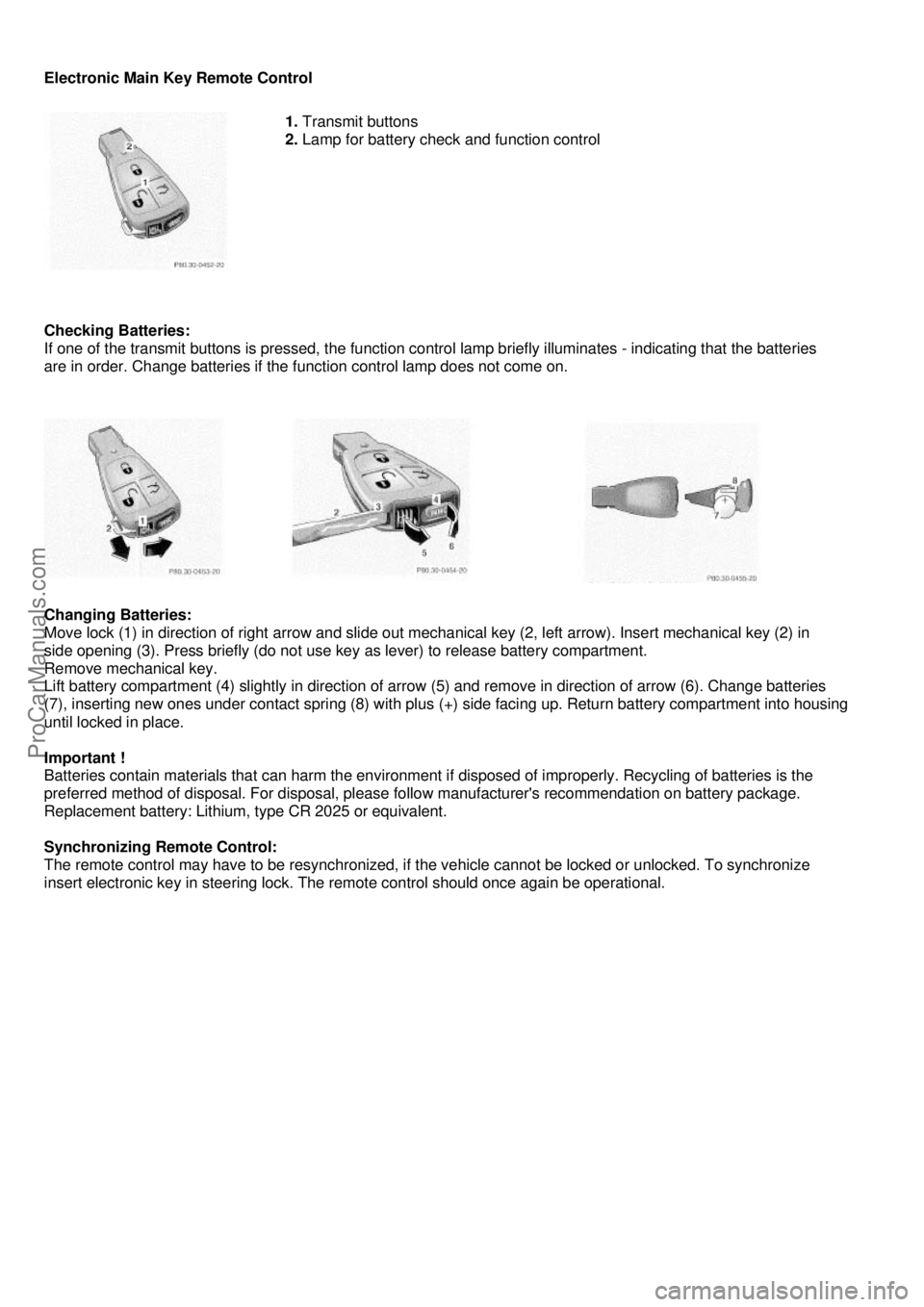1999 MERCEDES-BENZ C-280 light
[x] Cancel search: lightPage 89 of 122

Tire Inflation Pressure
A table (see fuel filler flap) lists the tire inflation pressures specified for Mercedes-Benz recommended tires as well as
for the varying operating conditions.
Important !
Tire pressure changes by approx. 1.5 psi (0.1 bar) per 18°F (10°C) of air temperature change. Keep this in mind
when checking tire pressure inside a garage - especially in the winter.
Example:
If garage temperature = approx. +68°F (+20°C) and ambient te mperature = approx. +32°F (0°C) then the adjusted air
pressure = specified air pressure +3 psi (+0.2 bar).
Tire pressures listed for light loads are minimum values o ffering high driving comfort. Increased inflation pressures for
heavy loads produce favorable handling characteristics with lighter loads arid are perfectly permissible. The ride of
the vehicle, however, will become somewhat harder.
Tire temperature and pressure increase with the vehicle speed. Tire pressure should therefore only be corrected on
cold tires. Correct tire pressure in warm tires only if pressure has dropped below the pressure listed in the table and
the respective operating conditions are taken into consideration.
An underinflated tire due to a slow leak (e.g. due to a
nail in the tire) may cause damage such as tread separation, bulging etc.. Regular tire pressure checks (including the
spare tire) at intervals of no more than 14 days are therefore essential. If a tire constantly loses air, it should be
inspected for damage.
Warning !
Do not overinflate tires. Overinfiating tires can result in sudden deflation (blowout) because they are more
likely to become punctured or damaged by road debris, potholes etc.. Follow recommended inflation
pressures.
Do not overload the tires by exceeding the specified vehicle capacity weight (as indicated by the label on the
driver's door latch post). Overloading the tires can overheat them, possibly causing a blowout.
ProCarManuals.com
Page 97 of 122

Jump Starting
Warning !
Failure to follow these directions will cause damage to the electronic components, and can lead to a battery
explosion and severe injury or death. Never lean over batteries while connecting or jump starting, you might
get injured. Battery fluid contains sulfuric acid. Do not allow this fluid to come in contact with eyes, skin or
clothing. In case it does, immediately flush affected ar ea with water, and seek medical help if necessary.
A battery will also produce hydrogen gas, which is flammable and very explosive. Keep flames or sparks
away from battery, avoid improper connection of jumper cables, smoking etc.. Read all instructions before
proceeding.
If the battery is discharged, the engine should be started with jumper cables and the (12 V) battery of another vehicle.
The battery is located in the trunk under the trunk floor.
Proceed as follows:
1 . Position the vehicle with the charged battery so that the jumper cables will reach, but never
let the vehicles touch. Make sure the jump er cables do not have loose or missing insulation.
2. On both vehicles:
• Turn off engine and all lights and acce ssories, except hazard warning flashers or
work lights.
• Apply parking brake and shift selector lever to position "P".
Important !
3. Clamp one end of the first jumper cable to the positive (+) terminal of the discharged
battery and the other end to the positive (+ ) terminal of the charged battery. Make sure
the cable clamps do not touch any other metal parts.
4. Clamp one end of the second jumper cable to the grounded negative (-) terminal of the
charged battery and the final connection to the negative (-) terminal of the discharged battery.
Important !
5. Start engine of the vehicle with the charged battery and run at high idle. Make sure the
cables are not on or near pulleys, fans, or other parts that will move when the engine is
started. Allow the discharged battery to charge for a few minutes. Start engine of the
disabled vehicle in the usual manner.
6. After the engine has started, remove jumper cables exactly reversing the above
installation sequence, starting with the last connection made first. When removing each
clamp, make sure that it does not touch any other metal while the other end is still attached.
Important !
A discharged battery can freeze at approx. +14°F (-10°C ). In that case, it must be thawed out before
jumper cables are used. A frozen battery can explode and cause personal injury.
Jumper cable specifications:
• Minimum cable cross-section of 25 mm
2 or approx. 2 AWG
• Maximum length of 11.5 ft. (3.5 m).
ProCarManuals.com
Page 99 of 122

Cleaning and Care of the Vehicle
Warning !
Many cleaning products can be hazardous. Some are poisonous, others are flammable.
Always follow the instructions on the particular container. Always open your car's doors or
windows when cleaning the inside. Never use fluids or solvents that are not designed for
cleaning your car.
In operation, your vehicle is subjected to varying external influences which, if gone unchecked, can
attack the paintwork as well as the underbody and cause lasting damage.
Such damage is caused not only by extreme and varying climatic conditions, but also by air
pollution, road salt, tar, gravel and stone chipping. Grease and oil, fuel, coolant, brake fluid, bird
droppings, insects, tree resins etc. should be removed immediately to avoid paint damage. Frequent
washing reduces and/or eliminates the aggr essiveness and potency of the above adverse
influences.
More frequent washings are necessary to deal with unfavorable conditions; for example, near the
ocean, in industrial areas (smoke, exhaust emissions), or during winter operation.
You should check your vehicle from time to time for stone chipping or other damage. Any damage
should be repaired as soon as possible to prevent the start of corrosion. In doing so, do not neglect
the underside of the car. A prerequisite for a t horough check is a washing of the underbody followed
by a thorough inspection. Damage d areas need to be reundercoated.
Your vehicle has been treated at the factory with a wax-base rustproofing in the body cavities which
will last for the lifetime of t he vehicle. Post-production treatment is neither necessary nor
recommended by Mercedes-Be nz because of the possibility of incompatibility between materials
used in the production proc ess and others applied later.
We have selected car care products and compiled recommendations which are specially matched to
our vehicles and which always reflect the late st technology. You can obtain Mercedes- Benz
approved car care products at your authorized Mercedes-Benz dealer.
Scratches, corrosive deposits, corrosion or damage due to negligent or incorrect care cannot always
be removed or repaired with the car care products recommended here. In such cases it is best to
seek aid at your authorized Mercedes-Benz dealer. The following topics deal with the cleaning and
care of your vehicle and give important "how-to" in formation as well as references to Mercedes-Benz
approved car care products. Additional information can be found in the booklet titled "Car Care".
Engine Cleaning
Prior to cleaning the engine compartment make sure to protect electrical components and
connectors from the intrusion of water and cleaning agents.
Corrosion protection, such as MB Anticorrosion Wax should be applied to the engine compartment
after every engine cleaning. Before applying, all control linkage bushings and joints should be
lubricated. The poly-V-belt and all pulleys should be protected from any wax.
Car Washing
Do not use hot water or wash your car in direct sunlight. Use only a mild car wash detergent, such
as Mercedes-Benz approved Car Shampoo.
Thoroughly spray the car with a diffused jet of wa ter. Direct only a very weak spray towards the
ventilation intake. Use plenty of water an d rinse the sponge and chamois frequently.
Rinse with clear water and thoroughly wipe dry with a chamois. Do not allow cleaning agents to dry
on the finish. If the vehicle has been run through an automatic car wash - in particular one of the
older installations - rewipe the recessed sections in the taillamps (designed to prevent soiling) if
necessary. No solvents (fuels, thi nners etc.) must be used. In the winter, thoroughly remove all
traces of road salt as soon as possible.
When washing the underbody, do not forget to clean the inner sides of the wheels.
Tar Stains
Quickly remove tar stains before they dry and beco me more difficult to remove. A tar remover is
recommended.
Window Cleaning
Use a window cleaning solution on all glass surfac es. An automotive glass cleaner is recommended.
ProCarManuals.com
Page 100 of 122

Wiper Blade
Clean the wiper blade rubber with a clean cloth and detergent solution. Replace blade twice a year;
once before and once after winter.
Headlamp Cleaning System
The condition of the wiper blades is important for satisfactory cleaning of the headlamp lenses. We
therefore recommend that the blades be insp ected regularly. Replace damaged wiper blades.
Paintwork. Painted Body Components
Mercedes-Benz approved Paint Care should be a pplied when water drops on the paint surface do
not "bead up"; normally in 3 to 5 months, depending on climate and washing detergent used.
Mercedes-Benz approved Paint Cleaner should be ap plied if paint surface shows signs of dirt
embedding (i.e. loss of gloss). Do not apply any of t hese products or wax if your car is parked in the
sun or if the hood is still hot. Use the appropriate MB-Touch-Up Stick for quick and provisional
repairs of minor paint damage (i.e. chips from stones, car doors etc.).
Seat Belts
The webbing must not be treated with chemical cleaning agents. Use only clear, lukewarm water
and soap. Do not dry the webbing at temperatures above 176°F (80°C) or in direct sunlight.
Warning !
Do not bleach or dye seat belts as this may severely weaken them. In a crash they may not be
able to provide adequate protection.
Hard Plastic Trim Items
Pour Mercedes-Benz approved Interior Care onto so ft lint-free cloth and apply with light pressure.
Headliner and Shelf below Rear Window
Clean with soft bristle brush, or use a dry- shampoo cleaner in case of excessive dirt.
Plastic and Rubber Parts
Do not use oil or wax on these parts.
Steering Wheel and Gear Selector Lever
Wipe with a damp cloth and dry thoroughly or clean with Mercedes-Benz approved Leather Care.
Light Alloy Wheels
Mercedes-Benz approved Wheel Care should be used for regular cleaning of the light alloy wheels.
If possible, clean wheels once a week with Merc edes-Benz approved Wheel Care, using a soft
bristle brush and a strong spray of water. Follow instructions on container.
Note:
Use only acid-free cleaning materials. The acid could lead to corrosion.
Ornamental Moldings
For regular cleaning and care of very dirty chrome-plated parts, use a chrome cleaner.
Upholstery
Using aftermarket seat covers or wearing clothing that have the tendency to give off coloring (e.g.
when wet etc.) may cause the upholstery to become permanently discolored. By lining the seats with
a proper intermediate cover, contac t-discoloration will be prevented.
Leather Upholstery Wipe leather upholstery with a damp cloth and dry thoroughly or clean with
Mercedes-Benz approved Leather Care. Exercise particular care when cleaning perforated leather
as its underside should not become wet.
MB Tex Upholstery Pour Mercedes-Benz approved In terior Care onto soft lint-free cloth and apply
wi
th light pressure.
ProCarManuals.com
Page 102 of 122

Electronic Main Key Remote Control
1. Transmit buttons
2. Lamp for battery check and function control
Checking Batteries:
If one of the transmit buttons is pressed, the function contro l lamp briefly illuminates - indicating that the batteries
are in order. Change batteries if the function control lamp does not come on.
Changing Batteries:
Move lock (1) in direction of right arrow and slide out mechanical key (2, left arrow). Insert mechanical key (2) in
side opening (3). Press briefly (do not use ke y as lever) to release battery compartment.
Remove mechanical key.
Lift battery compartment (4) slightly in direction of arrow (5) and remove in direction of arrow (6). Change batteries
(7), inserting new ones under contact spring (8) with plus (+) side facing up. Return battery compartment into housing
until locked in place.
Important !
Batteries contain materials that can harm the environment if disposed of improperly. Recycling of batteries is the
preferred method of disposal. For disposal, please fo llow manufacturer's recommendation on battery package.
Replacement battery: Lithium, type CR 2025 or equivalent.
Synchronizing Remote Control:
The remote control may have to be resynchronized, if t he vehicle cannot be locked or unlocked. To synchronize
insert electronic key in steering lock. The remote control should once again be operational.
ProCarManuals.com
Page 110 of 122

Technical Data C 230
Model C 230 (202 023)1 Rims - Tires
Engine 111 Rims (light alloy rims) 7J x 15 H 2
Mode of operation 4-stroke engine,
gasoline injection
Wheel offset 1.46 in (37 mm)
No. of cylinders
4 All season;Radial-ply tires 205/60 R 15 91 H
Bore 3.58 in (90.90 mm) Winter tires;Radial-ply tires 205/60 R 15 91 T M+S
Stroke 3.48 in (88.40 mm) Model C 230- Canada only
Total piston displacement 140.1 cu.in. (2295 cm3) Rims (steel rims) 61/2J x 15 H 2
Compression ratio 10,4:1 Wheel offset 1.46 in (37 mm)
Output acc. to SAE J 1349 148 hp/5500 rpm
(110 kW/5500 rpm)
All season;Radial-ply tires 195/65 R 15 91 H
Maximum torque acc. to SAE
J 1349
162 ft.lb./4000 rpm
(220 Nm/40OOrpm)
Winter tires;Radial-ply tires
195/65 R 15 91 T M+S
Maximum engine speed 6000 rpm Electrical System
Firing order 1-3-4-2 Generator (alternator) 14 V/90 A
Poly-V-belt 2155 mm Starter motor 12 V/1.4KW
Main Dimensions Battery 12 V/100 Ah
Overall vehicle length 177.4 in (4507 mm) Spark plugs Bosch F 9 DCO
Overall vehicle width 67.7 in (1720mm) Beru 14 F-9 DUO
Overall height 56.1 in (1424 mm)
Champion C 12 YCC
Wheel base 105.9 in (2690 mm) Electrode gap 0.032 in (0,8 mm)
Track, front 59.0 in (1499 mm) Tightening torque 15-22ft.lb. (20-30 Mm)
Track, rear 57.6 in (1464mm)
Weights See certification tag
Roof load max. 220 lb(100 kg)
Trunk load max 220 lb(100 kg)
1 The quoted data apply only to the standard vehicle. See an authorized Mercedes-Benz
dealer for the correspon-ding data of ali special bodies and special equipment,
ProCarManuals.com
Page 111 of 122

Technical Data C 280
Model C 280 (202 029)1 Rims - Tires
Engine 112 Rims (light
alloy rims)
7J x 15 H 2
Mode of operation 4-stroke engine,
gasoline injection
Wheel
offset
1.46 in (37 mm)
No. of cylinders 6
Summer
tires;
Radial-ply
tires
205/60R 15 91 H
Bore 3.54 in (89.90 mm)
Winter
tires;
Radial-ply
tires
205/60 R 15 91 T M+S
Stroke 2.89 in (73.50 mm)
Rims and All season Tires ( Sport Package)
Rims (light alloy rims) 7J x 16 H 2
Wheel offset 1.46 in (37 mm)
Summer tires;
Radial-ply tires
205/55 R 16 91 H
Electrical System
Total piston displacement 170.8 cu.in. (2799 cm3) Generator
(alternator) 14 V/90 A
Compression ratio 10:1
Starter
motor
12 V/1.7KW
Output acc. to SAE J
1349
195 hp/5800 rpm
(145 kW/5800 rpm)
Battery 12 V/100 Ah
Maximum torque acc.
to SAE J 1349
195 ft.lb./3000 rpm
(265 Nm/3000rpm)
Spark
plugs
Electrode
gap
Tightening
torque
Bosch F 9 DPER
0.032 in (0,8 mm)
15-22ft.lb. (20-30 Mm)
Maximum engine speed 6000 rpm Main Dimensions
Firing order 1-4-3-6-2-5 Overall
vehicle
length
177.4 in (4507 mm)
Poly-V-belt 2390 mm
Overall
vehicle
width
67.7 in (1720mm)
Weights: See certification tag
Overall
height
56.1 in (1424 mm)
Roof load max. 220 lb(100 kg) Wheel
base
105.9 in (2690 mm)
Trunk load max. 220 lb(100 kg) Track,
front
59.0 in (1499 mm)
Track, rear57.6 in (1464mm)
1 The quoted data apply only to the standard vehicle. See an authorized Mercedes-Benz dealer
for the correspon-ding data of ali special bodies and special equipment,
ProCarManuals.com
Page 112 of 122

Technical Data C 43 AMG
Model C 43 AMG (202 033)1 Rims and All season Tires
Engine 113 Rims2
Front axle
AMG light
alloy rims
Wheel
offset
71/2J x 17 H 2
1.38 in (35 mm)
Mode of operation 4-stroke engine,
gasoline injection
Rear axle
AMG light
alloy rims
Wheel
offset
8
1/2J x 17 H 2
1.18 in (30 mm)
No. of cylinders 8
Radial-ply
tires
Front axle
Rear axe
225/45 ZR 173
245/40 ZR 173
Bore 3.54 in 89.90 mm)
Rims and
Winter
Tires
Stroke
3.31 in (84.00 mm)
Rims2
AMG light alloy rims 71/2J x 17 H 2
Wheel offset 1.38 in (35 mm)
Radial-ply tires
or
215/45 R 17 H M + S
225/45 R 17 H M + S 3
Spare Wheel
Rims2
AMG light alloy rims 71/2J x 17 H 2
Wheel offset 1.38 in (35 mm)
All season tire:
Radial-ply tire
225/45 ZR 173
Electrical System
Total piston displacement 260.0 cu.in. (4265 cm3) Generator
(alternator)14 V/150 A
Compression ratio 10:1
Starter
motor
12 V/1.7KW
Output acc. to SAE J
1349
302 hp/5850 rpm
(225 kW/5850 rpm)
Battery 12 V/100 Ah
Maximum torque acc.
to SAE J 1349
302ft.lb./3250 rpm
(410 Nm/3250rpm)
Spark
plugs
Electrode
gap
Tightening
torque
Bosch F 8 DEPER
0.032 in (0,8 mm)
15-22ft.lb. (20-30 Mm)
Maximum engine speed 6300 rpm
Main Dimensions
Firing order 1-5-4-2-6-3-7-8
Overall
vehicle
length
177.4 in (4507 mm)
Poly-V-belt 2390 mm
Overall
vehicle
width 67.7 in (1720mm)
Overall
height
56.1 in (1424 mm)
Wheel
base 105.9 in (2690 mm)
Track,
front
59.2 in (1503 mm)
Weights See certification tag Tra ck, rear 58.2 in (1478mm)
ProCarManuals.com